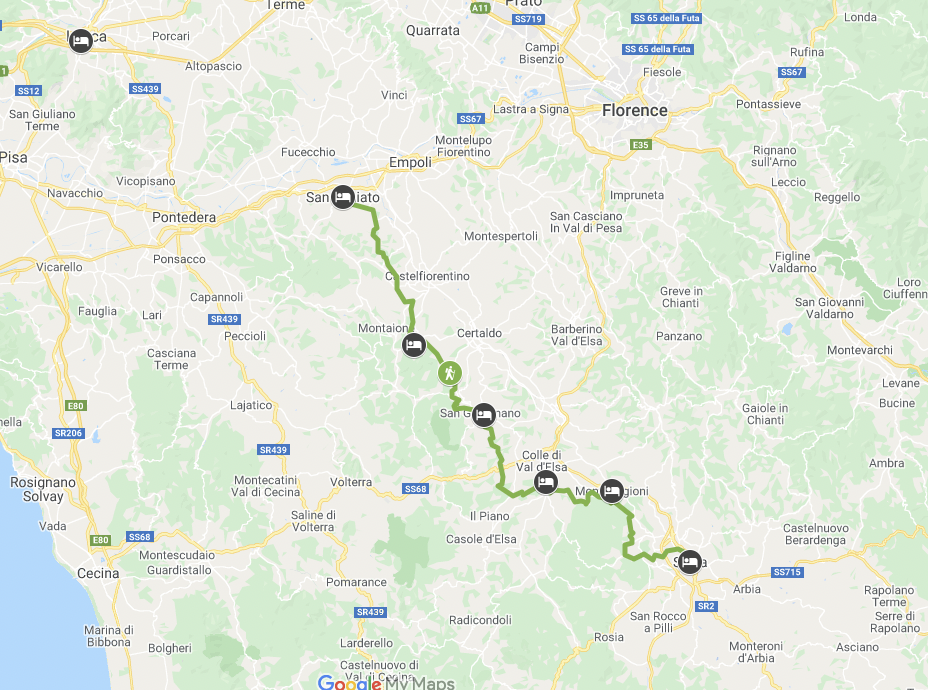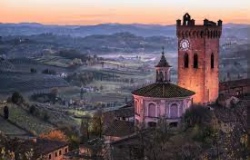Item Description
At the beginning of the second millennium, a huge number of pilgrims began crossing through Europe in search of the lost “Celestial Land”, the “Patria Celeste”. The pilgrims travelled to three major destinations: Rome, the city of the martyrdom of Saints Peter and Paul (the founders of the Christian Church). The Holy Land, site of Calvary, where the pilgrims sought out the places of Christ’s Passion; Santiago de Compostela, the furthest point of Western Europe which the Holy Apostle James chose as his final resting place. The way to Rome, Via Francigena (or Via Romea) which led to the Eternal City from the Western Alps and the Rhineland, was used for 7 centuries by sovereigns, emperors, plebeians and clergymen and was probably the most important road of the times. The Via Francigena led all the way from Canterbury to Rome and was one of the pathways of European history. It was a main thoroughfare along which hundreds of thousands of pilgrims passed on their way to Rome. In those days, the journey was not just an adventure or a risk but an act of devotion in itself, and the pilgrims would stop off along the way at places deemed holy by the Church. Nowadays, we are able to reconstruct the itinerary thanks to a document left behind by Archbishop Sigeric of Canterbury, who, upon his return from Rome to his dioceses in 994, wrote down the names of the places that had formed the stages of his journey home. It is only natural that one thousand years later, on the eve of a new millennium, there should be a reawakening of interest in the old route and a desire to rediscover a road that once represented unity and communication between the different cultures and ideas of European nations which are once again opening their borders. The Via Francigena bears witness to how even then there was a desire for unity in Europe. The route cut through the Alps in the Valley of Aosta and proceeded southwards through Piedmont, Lombardy, the flatlands of the River Po (Padania), before going through the Apennines near Berceto to pass into Tuscany and Latium, and ends in Rome. This “way to Rome” is an essential and formative phenomenon in the history of Europe. Fragments and reminders of its existence are still to be found scattered throughout our area.
The Northern Tuscany Section of the Via Francigena
The trip starts in Lucca where you can spend a day visiting its beautiful gardens and villas, or some of its nearly hundred churches that characterized this beautiful town. Lucca owed great part of its wealth to the trade along the Via Francigena. Coming from the plain the town could be easily reached along one of two parallel roads, the “via de supra” and the “via de subtus”. The famous wooden crucifix known as Volto Santo, work of Nicodemos as the legend goes, a sculpture with reliquary kept in the cathedral of San Martino, was the first thing the pilgrims bound for Lucca went to see. Inside the town a number of Hospitals attached to the main churches provided shelter and food for the pilgrims. To avoid a long part on asphalt and sometime busy road, you can take a train to Fucecchio where you will be picked up and taken to your hotel in San Miniato Alto on day 2 in the afternoon. This specific stage from Lucca to Siena, initially goes through the open and flat lands of the Val d’Elsa. In the second part you will deep into a medieval atmosphere evoked by the narrow streets and the buildings made from the local sandstone of some of the most popular medieval villages in Tuscany, such as Monteriggioni and San Gimignano that, with its thirteen outstanding towers, became an UNESCO world heritage in 1990. Reaching Siena, the landscape is made of open rolling hills with grey crags of the beautiful and picturesque Crete Senesi
- Spectacular landscapes, fascinating Tuscany countryside full of vineyards and the picturesque rolling hills of the Crete Senesi
- Amazing round walls of the historical fortified military village of Monteriggioni
- The charming UNESCO towns of San Gimignano and Siena
- Small comfortable, family run accommodations with delicious Tuscan culinary specialities
| SEASON | APRIL THRU OCTOBER |
| DURATION | 8 DAYS/7 NIGHTS |
| DEPARTURE | DAILY |
| STARTING POINT | LUCCA |
| ENDING POINT | SIENA |
| ITINERARY | S. MINIATO – GAMBASSI – S. GIMIGNANO – GRACCIANO – MONTERIGGIONI |
| LENGTH OF HIKING | 98 KM |
| DIFFICULTY | 🔴 🔴 ⚪️ ⚪️ |
| ACCOMMODATIONS. | SELECTED B&B, HOTELS (3-4 STARS), FARM HOLIDAY |
| PRICE PER PERSON FROM | EURO 750 |
| CODE: SC-IITSM211 |

| See also different: | Walking Tours |
